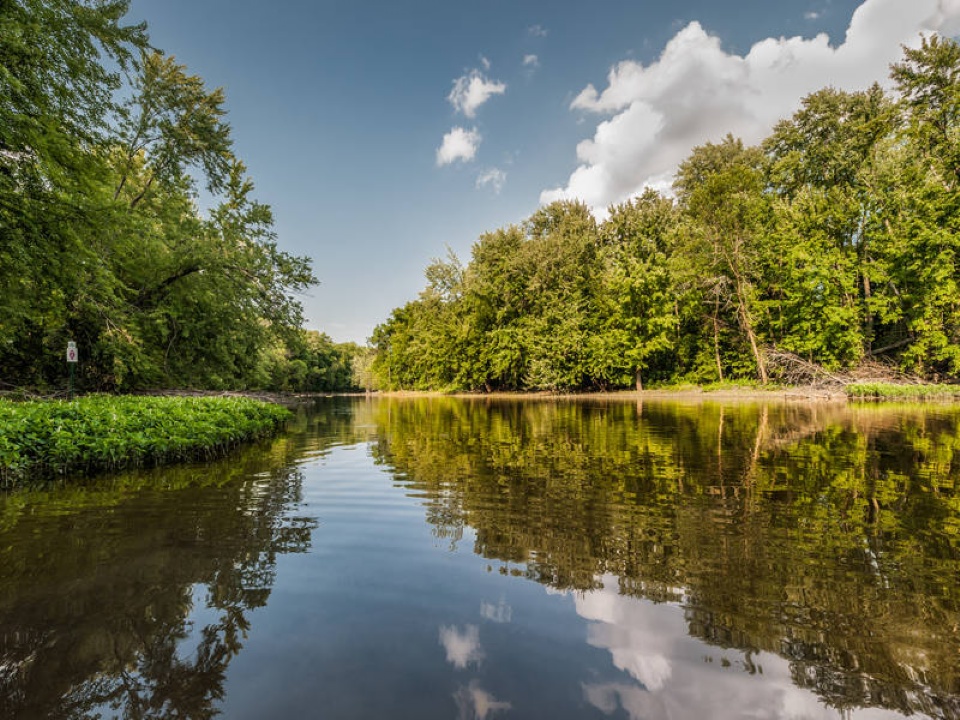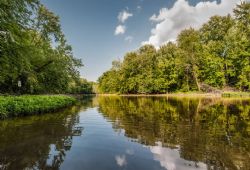Natural heritage is the beauty of the land untouched
by humans. With acres of natural landscapes, Laval has several beautiful
natural spots just like this. Here are just a few of the city’s best natural
heritage sites.
Rivière-des-Mille-Îles Wildlife Refuge
Founded by Éco-Nature
in 1987, Parc de la Rivière-des-Milles-Îles is a natural gem
with islands, bodies of water and shorelines. The 42 km park borders on nine
municipalities. Parc de la Rivière-des-Milles-Îles, where the
wildlife sanctuary is found, is a great spot for ecotourism activities.
The
refuge covers an area of 300 hectares. Very rich in biodiversity, this natural
environment is home to unique flora and fauna. The shelter is also home to
endangered and vulnerable animals. The Rivière-des-Mille-Îles
wildlife sanctuary is recognized both regionally and provincially for its
density, wildlife productivity and wildlife diversity. Its mission is to
preserve the integrity of this important wildlife habitat.
Protected
in 1998, the Rivière-des-Milles-Îles
wildlife sanctuary is made up of 10 islands covering 26.2 hectares of private
land belonging to the cities of Laval and Rosemère, as well as to Éco-Nature.
Bois de l’Équerre
Bois de l’Équerre is one of the last remaining great natural spaces north
of the city of Laval. Located in the Sainte-Rose district, Bois de l’Équerre is a natural refuge that contributes to the
quality of life of the people of Laval, thanks to dense trees and wetlands. Its
remarkable flora and fauna make it an ideal place for forest walks and bird
watching. The entire area is about 225 hectares.
Bois de l’Équerre is made up of more than 10 km of hiking trails. They are accessible to
all, for free, at all times. There is a large pavilion with over a dozen picnic
tables – ideal for hosting a gathering with friends and family. Bois de l’Équerre has 141 observed bird
species, 27 mammal species, 10 reptile and amphibian species, 37 herbaceous
species, 22 shrub species, and 22 tree species.
Bois Papineau
Bois Papineau is a real ecological gem and offers a landscape of
remarkably beautiful wildlife. Bois Papineau
is made up of two streams, a bicentennial beech forest, 220 plant species, 20
mammal species, 130 bird species, and 87 species of trees and shrubs.
Created
in 1986, the Association for the Conservation of Bois Papineau (ACBP) works to protect
Bois Papineau. Its goal is the
conservation and protection of the entire territory. The association's mission
is to promote ecological and environmental knowledge of this natural
environment. Located on Boulevard Saint-Martin, the services offered by Bois Papineau are numerous; chalets;
interpretation panels; rackets; walking trails; Nordic Ski; and free parking.
This is the perfect place to be surprised by the intimacy of the woods and to
take one of the courses to discover its diversity or its bicentenary beech –
part of what its known for.
Bois Sainte-Dorothée
Bois Sainte-Dorothée represents one-twelfth of the wooded area of Laval. It
is one of the three most important wooded areas of Île Jésus. At about 280 hectares – equivalent to about 466 football
fields – Bois Sainte-Dorothée is
known for its wide variety of habitats and unique plantlife.
In Bois Sainte-Dorothée, there are 262
vascular plant species including 48 tree species, 148 bird species, seven of
the eight species of Quebec bats, and more than 20 terrestrial mammals. Among
them are beavers, white-tailed deer, flying squirrels, coyotes and weasels. In Bois Sainte-Dorothée, there are also
four species of fish and 14 species of amphibians and reptiles. It also serves
as a refuge for 18 species of plants and animals whose survival is threatened.
For more information, visit laval.ca.
Translated
by Maria Barillaro

 In The Latest Issue:Latest Issue:
In The Latest Issue:Latest Issue:
- A Bittersweet Farewell
- The new Laval Aquatic Co...
- The End of an Era:
Articles
Calendar
Virtual- ANNUAL TEACHER APPRECIATION CONTEST
- APPUI LAVAL
- ARTS & CULTURE
- CAMPS
- CAR GUIDE
- CCIL
- CENTENNIAL ACADEMY
- CHARITY FUNDRAISING
- CITYTV
- COSMODÔME
- COMMUNITY CONNECTIONS
- COVER STORY
- DINA DIMITRATOS
- ÉCOLE SUPÉRIEURE DE BALLET DU QUÉBEC
- EDITORIALS
- ÉDUCALOI
- EDUCATION
- EMPLOYMENT & ENTREPRENEURSHIP
- FÊTE DE LA FAMILLE
- FÊTE DU QUARTIER SAINT-BRUNO
- FAMILIES
- FESTIVAL LAVAL LAUGHS
- FÊTE DE QUARTIER VAL-DES-BRISES
- FINANCES
- GLI CUMBARE
- GROUPE RENO-EXPERT
- HEALTH & WELL-BEING
- 30 MINUTE HIT
- ANXIETY
- CHILDREN`S HEALTH & WELLNESS
- CLOSE AID
- DENTAL WELLNESS
- EXTREME EVOLUTION SPORTS CENTRE
- FONDATION CITÉ DE LA SANTÉ
- GENERAL
- HEARING HEALTH
- MESSAGES FROM THE HEALTH AGENCY OF CANADA
- MENTAL HEALTH
- SEXUALITY
- SOCIAL INTEGRATION
- SPECIAL NEEDS
- TEENS
- THE NUTRITION CORNER
- THE NUTRITION CORNER - RECIPES
- VACATION DESTINATION
- WOMEN'S FITNESS
- WOMEN'S HEALTH
- HILTON MONTREAL/LAVAL
- HOME & GARDEN
- INTERNATIONAL WOMEN'S DAY
- JAGUAR LAVAL
- LAVAL À VÉLO
- LAVAL FAMILIES TV SHOW
- LAVAL FAMILIES MAGAZINE CARES
- LAVAL URBAN IN NATURE
- LE PARCOURS DES HÉROS
- LES PETITS GOURMETS DANS MA COUR
- LEON'S FURNITURE
- LEONARDO DA VINCI CENTRE
- LFM PREMIERES
- LIFE BALANCE
- M.P. PROFILE
- MISS EDGAR'S AND MISS CRAMP'S SCHOOL
- MISSING CHILDREN'S NETWORK
- NETFOLIE
- NORTH STAR ACADEMY LAVAL
- OUTFRONT MEDIA
- PASSION SOCCER
- PARC DE LA RIVIÈRE-DES-MILLE-ÎLES
- PÂTISSERIE ST-MARTIN
- PIZZERIA LÌOLÀ
- PLACE BELL
- PORTRAITS OF YOUR MNA'S
- ROCKET DE LAVAL
- SACRED HEART SCHOOL
- SCOTIA BANK
- SHERATON LAVAL HOTEL
- SOCIÉTÉ ALZHEIMER LAVAL
- STATION 55
- STL
- SUBARU DE LAVAL
- TECHNOLOGY
- TEDXLAVAL
- TODAY`S LAURENTIANS AND LANAUDIÈRE
- TODAY`S LAVAL
- WARNER MUSIC
- THIS ISSUE
- MOST RECENT
Magazine
The Natural Heritage of the City of Laval
Articles ~e 105,7 Rythme FM 4 chemins Annual Teacher Appreciation Contest Appui Laval Arts & Culture Ballet Eddy Toussaint Camps THIS ISSUE MORE...
CONTESTS Enter our contests
CONTESTS Enter our contests
CALENDAR
Events & Activities
COMMUNITY Posts Events
PUBLICATIONS Our Magazine Family Resource Directory
LFM BUSINESS NETWORK Learn more
COUPONS Click to save!
COMMUNITY Posts Events
PUBLICATIONS Our Magazine Family Resource Directory
LFM BUSINESS NETWORK Learn more
COUPONS Click to save!
SUBSCRIPTIONS
Subscribe to the magazine
Un-Subscribe
E-NEWSLETTER Subscribe to our E-newsletter Un-Subscribe
WRITE FOR US Guidelines & Submissions
POLLS Vote today!
E-NEWSLETTER Subscribe to our E-newsletter Un-Subscribe
WRITE FOR US Guidelines & Submissions
POLLS Vote today!
ADVERTISERS
How to & Media guide
Pay your LFM invoice
SUGGESTIONS Reader's Survey Suggest a Listing
LFM About Us Our Mission Giving Back Contact Us
SUGGESTIONS Reader's Survey Suggest a Listing
LFM About Us Our Mission Giving Back Contact Us
 PICK-UP LOCATIONS
Get a copy of LFM!
PICK-UP LOCATIONS
Get a copy of LFM!
TERMS & CONDITIONS Privacy | Terms
ISSN (ONLINE) 2291-1677
ISSN (PRINT) 2291-1677
Website by ZENxDESIGN



 BY:
BY: 
Tweet
Share